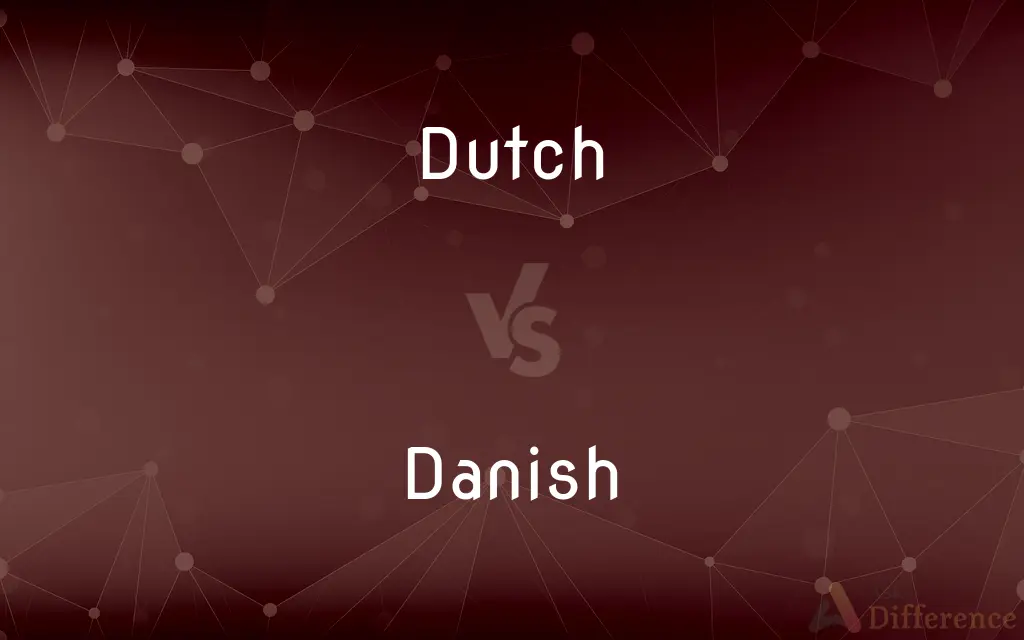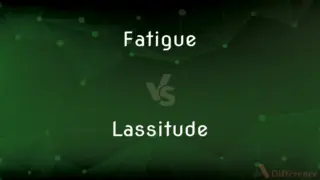Dutch vs. Danish — What's the Difference?
By Maham Liaqat & Fiza Rafique — Updated on March 24, 2024
Dutch pertains to the Netherlands and its people or language, while Danish relates to Denmark and its citizens or language.

Difference Between Dutch and Danish
Table of Contents
ADVERTISEMENT
Key Differences
Dutch is the official language of the Netherlands and is also spoken in Belgium and Suriname. It's a West Germanic language, closely related to German and English. Danish, on the other hand, is a North Germanic language spoken in Denmark and parts of northern Germany. It is closely related to Swedish and Norwegian, reflecting the historical connections within Scandinavia.
The Netherlands, associated with Dutch culture, is known for its flat landscape, extensive canal systems, tulip fields, windmills, and cycling routes. Denmark, reflecting Danish culture, is renowned for its Viking heritage, design, architecture, and welfare system. Both countries have made significant contributions to art, literature, and philosophy but are distinct in their cultural expressions and historical trajectories.
While Dutch cuisine is known for its dairy products, particularly cheese, and dishes like Stroopwafel and bitterballen, Danish cuisine emphasizes seafood, pastries (notably Danish pastries, ironically called "Vienna bread" in Denmark), and hearty meals. Each cuisine reflects the agricultural and climatic conditions of its country.
In terms of governance, both the Netherlands and Denmark are constitutional monarchies with a history of seafaring, trade, and exploration. They are both members of the European Union, sharing values of democracy, human rights, and economic cooperation, but each has its unique approach to social policy and governance.
Education systems in both countries are highly regarded, with a focus on innovation, creativity, and social equity. However, the structure and emphasis of educational programs may vary, reflecting the countries' differing societal needs and cultural values.
ADVERTISEMENT
Comparison Chart
Language Family
West Germanic
North Germanic
Geography
Known for flat landscapes, canals, tulip fields.
Known for coastal landscapes, Viking heritage.
Cuisine
Features dairy, Stroopwafel, bitterballen.
Known for seafood, Danish pastries, smørrebrød.
Government
Constitutional monarchy, parliamentary system.
Constitutional monarchy, parliamentary democracy.
Culture
Influential in art, philosophy, global trade.
Renowned for design, architecture, welfare model.
Education
Focuses on innovation, vocational training.
Emphasizes creativity, comprehensive welfare support.
Compare with Definitions
Dutch
Refers to the people, language, or culture of the Netherlands.
Dutch painters like Rembrandt and Van Gogh are celebrated worldwide.
Danish
Renowned for its Viking history and modern design.
Denmark's Viking ships are a testament to its rich maritime history.
Dutch
The Netherlands has a significant history of maritime trade.
The Dutch East India Company was a major force in global trade during the 17th century.
Danish
Danish is spoken mainly in Denmark and parts of northern Germany.
Danish, Swedish, and Norwegian share linguistic similarities.
Dutch
Dutch cuisine includes a variety of dairy products.
Gouda and Edam are popular Dutch cheeses known globally.
Danish
Denmark is known for its welfare model and quality of life.
Danish society is characterized by high levels of equality and social trust.
Dutch
Famous for its tulip fields and cycling culture.
The Dutch landscape is adorned with colorful tulip fields each spring.
Danish
Cuisine is notable for its pastries and smørrebrød.
Danish pastries, despite their name, originated from Austria but are a staple in Denmark.
Dutch
The language is spoken in the Netherlands, Belgium, and Suriname.
Dutch is known for its guttural sounds and close relation to German.
Danish
Pertains to Denmark, its people, or language.
Danish design is admired for its simplicity and functionality.
Dutch
Of or relating to the Netherlands or its people or culture.
Danish
Of or relating to Denmark, the Danes, their language, or their culture.
Dutch
Of or relating to the Dutch language.
Danish
The North Germanic language of the Danes.
Dutch
German.
Danish
Pl. Danish or Dan·ish·es A Danish pastry.
Dutch
Of or relating to any of the Germanic peoples or languages.
Danish
Danish pastry, light sweet yeast-raised roll usually filled with fruit or cheese.
Get me a coffee and a cheese danish.
Dutch
Of or relating to the Pennsylvania Dutch.
Danish
Belonging to the Danes, or to their language or country.
Dutch
The people of the Netherlands.
Danish
A Scandinavian language that is the official language of Denmark
Dutch
(Archaic) A Germanic people.
Danish
Light sweet yeast-raised roll usually filled with fruits or cheese
Dutch
The Pennsylvania Dutch.
Danish
Of or relating to or characteristic of Denmark or the Danes;
Danish furniture
Dutch
The official West Germanic language of the Netherlands and one of the official languages of Belgium.
Dutch
(Archaic) One or more of the West Germanic languages of Germany, Switzerland, and the Low Countries.
Dutch
See Pennsylvania Dutch.
Dutch
(Slang) Anger or temper.
Dutch
(slang) wife
Dutch
Pertaining to Holland, or to its inhabitants.
Germany is slandered to have sent none to this war [the Crusades] at this first voyage; and that other pilgrims, passing through that country, were mocked by the Dutch, and called fools for their pains.
Dutch
The people of Holland; Dutchmen.
Dutch
The language spoken in Holland.
Dutch
The people of the Netherlands;
The Dutch are famous for their tulips
Dutch
The West Germanic language of the Netherlands
Dutch
Of or relating to the Netherlands or its people or culture;
Dutch painting
Dutch painters
Common Curiosities
Are Dutch and Danish languages similar?
Despite both being Germanic languages, Dutch is West Germanic and Danish is North Germanic, making them distinct with different linguistic characteristics.
Can Dutch and Danish people understand each other's languages?
Generally, no. Despite some similarities, the languages are sufficiently different to require learning the other to understand it well.
What is the main difference between Dutch and Danish?
The main difference lies in their association; Dutch is related to the Netherlands and Danish to Denmark, including differences in language, culture, and geography.
What are some cultural highlights of Denmark?
Denmark is celebrated for its Viking history, modern design and architecture, and its comprehensive welfare model.
Is the landscape in the Netherlands and Denmark similar?
Both countries feature flat terrains ideal for cycling; however, the Netherlands is noted for its extensive canal systems and tulip fields, while Denmark is known for its coastal landscapes.
What are typical features of Dutch cuisine?
Dutch cuisine is known for its dairy products, hearty meals, and snacks like Stroopwafel and bitterballen.
What kind of government do the Netherlands and Denmark have?
Both are constitutional monarchies, but their systems of governance and social policies reflect their unique histories and cultural values.
Are Dutch and Danish part of the European Union?
Yes, both the Netherlands and Denmark are members of the European Union, sharing commitments to democracy, human rights, and economic cooperation.
How do the educational systems in the Netherlands and Denmark differ?
While both prioritize high-quality education, they differ in structure, focus, and the way social equity is integrated into the educational experience.
What makes Danish design unique?
Danish design is known worldwide for its minimalism, functionality, and aesthetic appeal, often reflecting the values of simplicity and practicality.
Share Your Discovery

Previous Comparison
Link vs. URL
Next Comparison
Fatigue vs. LassitudeAuthor Spotlight
Written by
Maham LiaqatCo-written by
Fiza RafiqueFiza Rafique is a skilled content writer at AskDifference.com, where she meticulously refines and enhances written pieces. Drawing from her vast editorial expertise, Fiza ensures clarity, accuracy, and precision in every article. Passionate about language, she continually seeks to elevate the quality of content for readers worldwide.












































